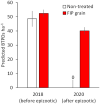Assembling a safe and effective toolbox for integrated flea control and plague mitigation: Fipronil experiments with prairie dogs
- PMID: 35939486
- PMCID: PMC9359584
- DOI: 10.1371/journal.pone.0272419
Assembling a safe and effective toolbox for integrated flea control and plague mitigation: Fipronil experiments with prairie dogs
Abstract
Background: Plague, a widely distributed zoonotic disease of mammalian hosts and flea vectors, poses a significant risk to ecosystems throughout much of Earth. Conservation biologists use insecticides for flea control and plague mitigation. Here, we evaluate the use of an insecticide grain bait, laced with 0.005% fipronil (FIP) by weight, with black-tailed prairie dogs (BTPDs, Cynomys ludovicianus). We consider safety measures, flea control, BTPD body condition, BTPD survival, efficacy of plague mitigation, and the speed of FIP grain application vs. infusing BTPD burrows with insecticide dusts. We also explore conservation implications for endangered black-footed ferrets (Mustela nigripes), which are specialized predators of Cynomys.
Principal findings: During 5- and 10-day laboratory trials in Colorado, USA, 2016-2017, FIP grain had no detectable acute toxic effect on 20 BTPDs that readily consumed the grain. During field experiments in South Dakota, USA, 2016-2020, FIP grain suppressed fleas on BTPDs for at least 12 months and up to 24 months in many cases; short-term flea control on a few sites was poor for unknown reasons. In an area of South Dakota where plague circulation appeared low or absent, FIP grain had no detectable effect, positive or negative, on BTPD survival. Experimental results suggest FIP grain may have improved BTPD body condition (mass:foot) and reproduction (juveniles:adults). During a 2019 plague epizootic in Colorado, BTPDs on 238 ha habitat were protected by FIP grain, whereas BTPDs were nearly eliminated on non-treated habitat. Applications of FIP grain were 2-4 times faster than dusting BTPD burrows.
Significance: Deltamethrin dust is the most commonly used insecticide for plague mitigation on Cynomys colonies. Fleas on BTPD colonies exhibit the ability to evolve resistance to deltamethrin after repeated annual treatments. Thus, more tools are needed. Accumulating data show orally-delivered FIP is safe and usually effective for flea control with BTPDs, though potential acute toxic effects cannot be ruled out. With continued study and refinement, FIP might be used in rotation with, or even replace deltamethrin, and serve an important role in Cynomys and black-footed ferret conservation. More broadly, our stepwise approach to research on FIP may function as a template or guide for evaluations of insecticides in the context of wildlife conservation.
Conflict of interest statement
The authors have declared that no competing interests exist.
Figures




Similar articles
-
Plague mitigation for prairie dog and black-footed ferret conservation: Degree and duration of flea control with 0.005% fipronil grain bait.Curr Res Parasitol Vector Borne Dis. 2023 May 25;3:100124. doi: 10.1016/j.crpvbd.2023.100124. eCollection 2023. Curr Res Parasitol Vector Borne Dis. 2023. PMID: 37305434 Free PMC article.
-
Evaluation of Five Pulicides to Suppress Fleas on Black-Tailed Prairie Dogs: Encouraging Long-Term Results with Systemic 0.005% Fipronil.Vector Borne Zoonotic Dis. 2019 Jun;19(6):400-406. doi: 10.1089/vbz.2018.2339. Epub 2019 Feb 6. Vector Borne Zoonotic Dis. 2019. PMID: 30620249
-
RESISTANCE TO DELTAMETHRIN IN PRAIRIE DOG ( CYNOMYS LUDOVICIANUS) FLEAS IN THE FIELD AND IN THE LABORATORY.J Wildl Dis. 2018 Oct;54(4):745-754. doi: 10.7589/2017-10-250. Epub 2018 May 3. J Wildl Dis. 2018. PMID: 29723100 Free PMC article.
-
Evaluation of Yersinia pestis Transmission Pathways for Sylvatic Plague in Prairie Dog Populations in the Western U.S.Ecohealth. 2016 Jun;13(2):415-27. doi: 10.1007/s10393-016-1133-9. Epub 2016 May 27. Ecohealth. 2016. PMID: 27234457 Review.
-
A review of public health important fleas (Insecta, Siphonaptera) and flea-borne diseases in India.J Vector Borne Dis. 2022 Jan-Mar;59(1):12-21. doi: 10.4103/0972-9062.328977. J Vector Borne Dis. 2022. PMID: 35708399 Review.
Cited by
-
Characterization in Potent Modulation on Voltage-Gated Na+ Current Exerted by Deltamethrin, a Pyrethroid Insecticide.Int J Mol Sci. 2022 Nov 25;23(23):14733. doi: 10.3390/ijms232314733. Int J Mol Sci. 2022. PMID: 36499059 Free PMC article.
-
Assessing potential collateral effects on amphibians from insecticide applications for flea control and plague mitigation.PLoS One. 2025 May 12;20(5):e0320382. doi: 10.1371/journal.pone.0320382. eCollection 2025. PLoS One. 2025. PMID: 40354371 Free PMC article.
-
Prairie dog responses to vector control and vaccination during an initial Yersinia pestis invasion.Int J Parasitol Parasites Wildl. 2023 Dec 9;23:100893. doi: 10.1016/j.ijppaw.2023.12.001. eCollection 2024 Apr. Int J Parasitol Parasites Wildl. 2023. PMID: 38179235 Free PMC article.
-
Plague mitigation for prairie dog and black-footed ferret conservation: Degree and duration of flea control with 0.005% fipronil grain bait.Curr Res Parasitol Vector Borne Dis. 2023 May 25;3:100124. doi: 10.1016/j.crpvbd.2023.100124. eCollection 2023. Curr Res Parasitol Vector Borne Dis. 2023. PMID: 37305434 Free PMC article.
-
Efficacy of a federally approved flea bait, orally administered to white-footed mice (Peromyscus leucopus), against blood feeding Ixodes scapularis larvae under simulated field conditions.Int J Parasitol Parasites Wildl. 2023 Apr 7;21:33-42. doi: 10.1016/j.ijppaw.2023.04.001. eCollection 2023 Aug. Int J Parasitol Parasites Wildl. 2023. PMID: 37124670 Free PMC article.
References
-
- Biggins DE, Kosoy MY. Influences of introduced plague on North American mammals: implications from ecology of plague in Asia. Journal of Mammalogy. 2001; 82:906–916.
Publication types
MeSH terms
Substances
LinkOut - more resources
Full Text Sources
Medical

